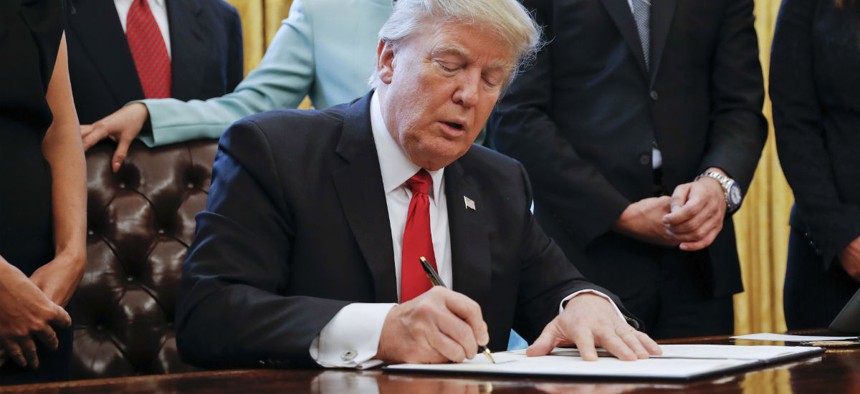Trump Signs One In, Two Out Order to Slash Federal Regulations
Agencies must now examine net costs of new and old regulations.
Federal agencies will soon have to significantly cut back their regulatory footprints, with President Trump on Monday signing an executive order that would require the government to shrink the costs of its regulations.
The executive order follows through on a campaign promise; starting immediately, federal agencies must cut two regulations for every one they institute. In fiscal 2017, agencies must have a net zero impact on regulatory costs. Starting in fiscal 2018, agencies must offset the costs of every new regulation by eliminating costs associated with at least two existing regulations. Also starting in the fiscal 2018 budget, the Office of Management and Budget director will create a cap for each agency dictating the regulatory costs they will be able to implement and cut annually.
White House Press Secretary Sean Spicer called the order the “most significant administrative action in the world of regulatory reform since President Reagan created” the Office of Information and Regulatory Affairs in 1981.
The OMB director will also create guidance to standardize how costs are measured. A Trump administration official told reporters the order “puts in place a process” for OMB to “work with all the agencies to manage their own regulatory review process.” Trump said last week he would slash regulations by 75 percent, though neither the order nor the officials addressed that claim. White House officials said the across-the-board regulatory freeze previously implemented by Chief of Staff Reince Priebus is now beginning to thaw.
Officials also said the timing must still be sorted out on exactly when agencies need to identify the outgoing regulations, and if that must happen in advance of a new regulation being issued. Agencies are currently identifying to OMB and the White House regulations that can be cut, the administration officials said. They added “the intention” as of now is to make public the regulations that are being eliminated.
The order allows for exemptions in cases of national security and emergencies.
Susan Dudley, who served as OIRA administrator under President George W. Bush, recently told Government Executive the difficulty of Trump’s regulatory agenda would come after the executive order.
“Operationally it’s going to be complicated to put into place,” said Dudley, who is now director at The George Washington University’s Regulatory Studies Center.
Those difficulties will take many forms; first, both the Bush and Obama administrations have already completed retrospective reviews that attempted to eliminate or streamline high-impact, unnecessarily burdensome regulations. The “low-hanging fruit” has already been picked, according to Amit Narang, a regulatory policy expert for Public Citizen.
“And the previous administrations did not find it easy,” Dudley added.
The Trump administration could also run into pushback from multiple avenues. Consumer groups such as Narang’s Public Citizen have warned Trump risks endangering the public by requiring a rollback of rules meant to protect Americans. Businesses may actually want to keep certain regulations on the books that have required them to make capital investments, as a repeal would give their competitors an advantage. Agencies themselves could also find it difficult to eliminate rules their employees think help carry out their missions, and they could decline to implement the regulations the Trump administration actually wants as leverage to protect those already on the books.
Young agencies, such as the Consumer Financial Protection Bureau, Narang said, may be hard-pressed to identify enough regulations to unwind, as they simply have not issued that many. The Environmental Protection Agency, as it releases a long-anticipated regulation on lead in drinking water, could be forced to roll back its existing rules on the subject.
Federal agencies will have to figure out to meet their statutory requirements while scaling back their regulatory reach, Dudley said. A positive impact of the policy, she said, is that it would give agencies incentives to focus on existing regulations, “what their impact is and how well they’re working.”
The current policy encourages agencies "really to think of the next regulation rather than to look back,” she said, adding the change could help agencies challenge their assumptions and calculations on cost-benefit analyses.
If agencies are forced to squeeze regulations into a certain cost framework, however, Narang argued it would “completely ignore the benefit side of the equation.”
NEXT STORY: Trump Has Trouble Making Obamacare Ads Disappear








